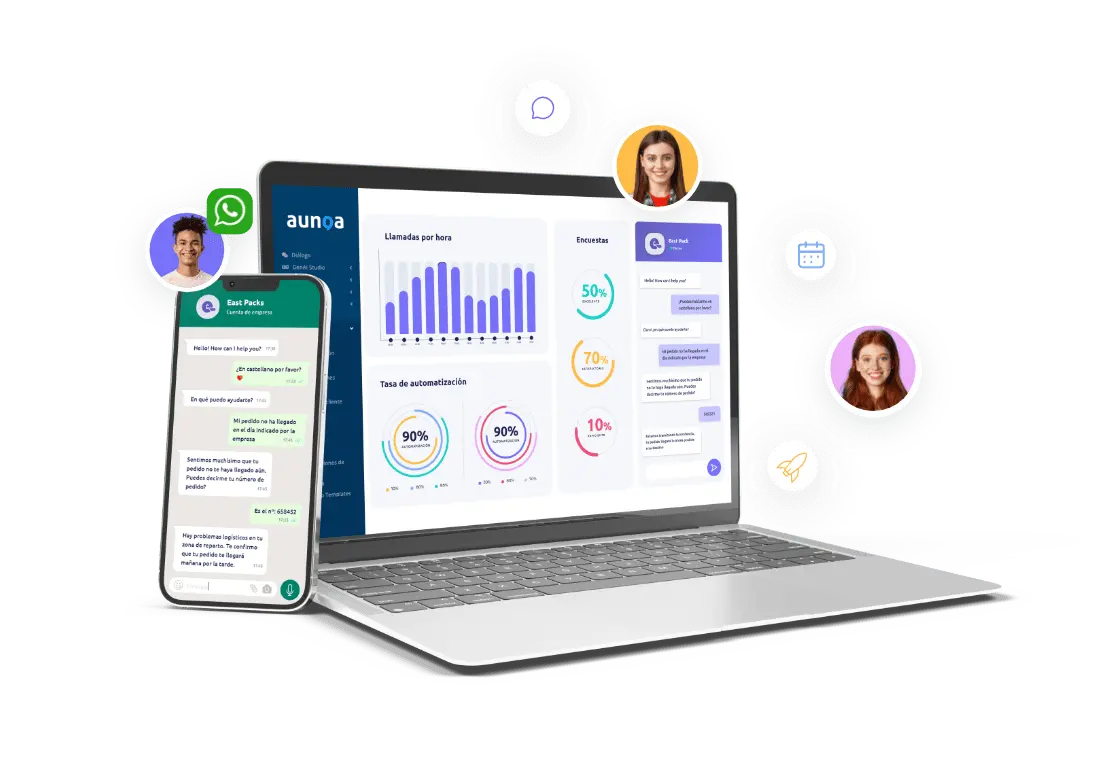Technology is advancing by leaps and bounds, and Artificial Intelligence (AI) has become a powerful tool for improving efficiency and the quality of customer service.
One example is the creation of virtual chat assistants, also known as chatbots. AI-powered chatbots have proven to be highly capable of automating tasks, streamlining processes, and providing personalized and efficient customer service 24/7.
In this article, we will explore the advantages of having a virtual assistant and how to create one.
What is a virtual assistant or chatbot?
A virtual assistant or chatbot is an Artificial Intelligence application designed to interact with users conversationally through text or voice messages. Its primary function is to answer users’ questions, provide specific information, and speed up processes by offering real-time assistance.
To achieve this, the tool employs technologies such as Natural Language Processing (NLP) and Machine Learning, enabling it to understand customer needs and deliver human-like conversations.
Virtual assistants are mainly used in areas such as Customer Service or Technical Support, aiming to enhance the user experience and streamline processes.
Advantages of a virtual assistant or chatbot
Here are some of the benefits of having a virtual assistant or chatbot in your Customer Service:
- 24/7 availability: One of the biggest benefits of a virtual assistant is its continuous availability. Unlike customer service teams that work within specific hours, a chatbot is available 24/7, allowing customers to resolve queries and issues anytime.
- Instant response: Virtual assistants provide immediate and accurate answers to frequently asked questions, reducing customer wait times and improving satisfaction.
- Cost reduction: Implementing a chatbot improves efficiency in customer service processes, allowing businesses to reduce operational costs in the medium term.
- Scalability: Chatbots can handle multiple conversations simultaneously without losing effectiveness. As customer service demand grows, the virtual assistant can easily adapt.
- Continuous learning: Thanks to Machine Learning, a virtual assistant can learn from every interaction and improve its performance over time, leading to higher customer satisfaction and increased brand loyalty.
How to create your virtual assistant?
If you’re considering developing a virtual assistant for your brand, here are some key aspects to keep in mind:
1. Understand user needs
Before starting the development of the virtual assistant or intelligent chatbot, conducting a detailed study of your audience and their needs is essential. Understanding the most common questions and issues customers face will help you tailor the chatbot’s capabilities to provide relevant and effective answers.
2. Train the chatbot with NLP
For a virtual assistant to be successful, it must be trained to understand and respond like a human customer service agent. Natural Language Processing (NLP) enables the chatbot to interpret human language and provide coherent and relevant responses.
It also requires knowledge in linguistics, psychology, semantics, and user experience design, among other disciplines. Combining these conversational skills creates a highly satisfying user experience.
3. Test before launching the intelligent chatbot
Before deploying the virtual assistant in a live environment, it is crucial to conduct extensive testing to ensure it meets your objectives. Ensure the chatbot is error-free and capable of handling most customer inquiries smoothly and effectively.
Additionally, the virtual assistant should be positioned prominently on the website, making it easily accessible to users.
4. Implement the virtual assistant or chatbot
Once the virtual assistant prototype is validated, it’s time to begin the implementation phase. At this stage, the intelligent chatbot should be tested with real users. Monitoring its performance and gathering user feedback is essential. This feedback will help the virtual assistant improve and optimize the customer experience.
The chatbot may not be able to answer all user queries. That’s why we recommend using a hybrid chatbot—one that can escalate conversations to human agents when questions become too complex or when the customer requests it. Users appreciate the speed and availability of a chatbot but also value the option of speaking with a human agent.
5. Keep data sources updated
A virtual assistant must stay up to date to provide accurate and helpful answers. Regularly reviewing the knowledge base from which it pulls data (ERP and other management platforms) and adding new relevant information when necessary is crucial.
Create your virtual assistant with Aunoa
Implementing an AI-powered virtual assistant is an increasingly popular trend due to its numerous benefits.
At Aunoa, we develop AI chatbots tailored to each client’s needs, automating up to 90% of Customer Service inquiries.
Free your agents from excessive workloads while instantly and effectively solving customer issues. Our expert team will help you create the right virtual assistant for your business.






